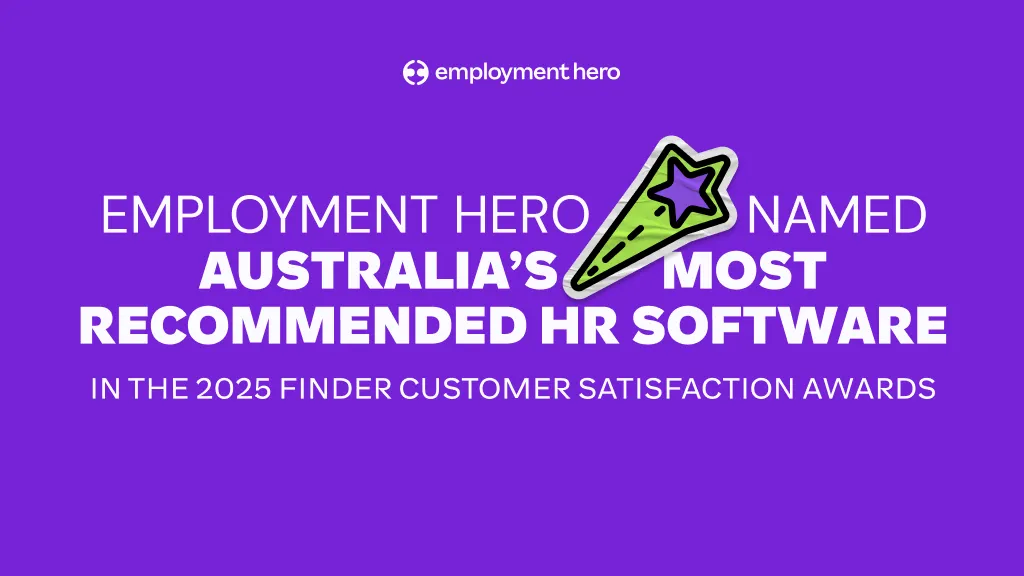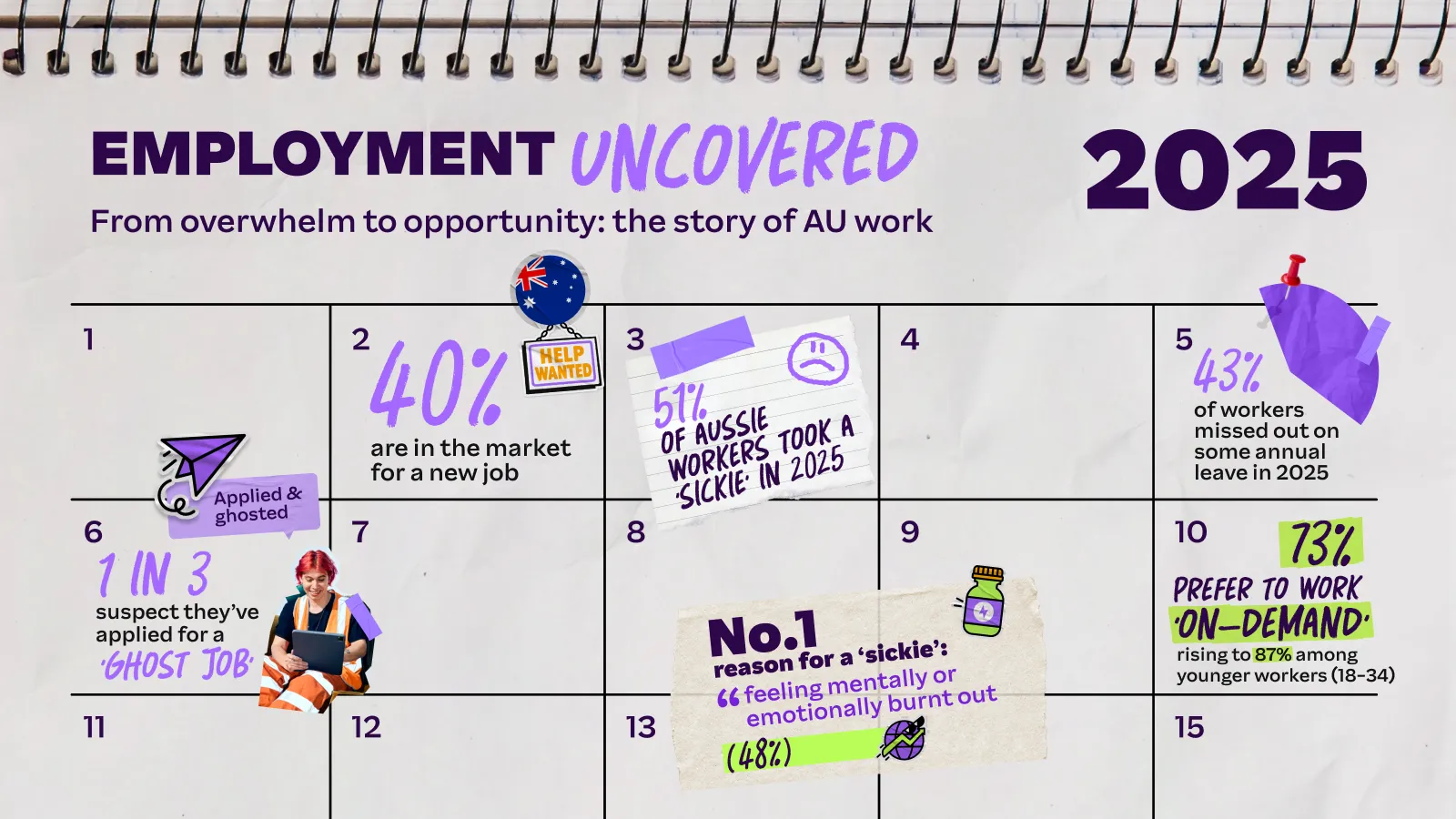Take a Break: How Employers Can Encourage Their Teams to Make the Most of Time Off
Top tips to help your team make the most of down time.

Even with the best wellbeing strategies in place, the workplace can still be a stressful and demanding environment, and it’s no secret that stress and burnout can have negative effects on our mental health.
That’s why it’s important for both you and your employees to prioritise mental health and wellbeing in the workplace. One simple yet powerful way to do this is by taking breaks, not just through the work day, but also through annual leave.
From seeking to foster a positive work environment to modelling healthy habits as a leader, the following tips can help you take a step in the right direction. So take a deep breath, relax, and let’s get started!
The many, many benefits of taking time off
Before we dive in, let’s take a moment to recap why taking time off is important. It’s easy to fall into the trap of thinking that pushing through long work hours and skipping breaks will make you more productive. But research suggests the opposite is actually true.
Indeed, taking breaks and taking time off has been shown to have extensive benefits for both employees and employers. Among the top benefits are increased productivity, and better happiness and wellbeing levels.

Improved productivity
Working for extended periods without breaks can lead to mental fatigue and decreased focus, ultimately leading to decreased productivity. Taking breaks can help employees recharge and return to work with renewed energy and focus.
Better mental health
The constant pressure to perform and meet deadlines can take a toll on employees’ mental health. Taking time off can help reduce stress levels, improve mood, and prevent burnout, ultimately leading to better mental health and wellbeing.
Overall wellbeing
In addition to improving mental health, taking time off can have a positive impact on an employee’s overall wellbeing. It can provide opportunities to connect with family and friends, pursue hobbies and interests, and engage in self-care activities that are often neglected due to work commitments.
The do’s and don’ts of encouraging time off
As an employer, it’s important to not only recognise the benefits of taking time off but also to actively encourage and support your employees in doing so.
There are some easy ways you can support and incentivise your employees to take a break, but there are pitfalls too. Here’s a list we put together:
Do’s:
-
Provide clear policies on annual leave and leave management
Employees are entitled to paid time off (PTO), and offering a more generous allowance than the statutory minimum can be a powerful strategy to attract and retain talent. But even ‘unlimited holiday’ can cause more harm than good when it isn’t supported by clear policies, and if there’s a lack of trust in the workforce.
A clear annual leave policy not only ensures that employees understand that they can have the time they need to recharge, but also communicates to them that their wellbeing is a priority for the company. Having a clear employee leave management process helps consistently and effectively handle employee leave requests, and can also boost employee satisfaction and retention levels.
-
Encourage your employees to take time off
Annual leave is a valuable opportunity for employees to take time off work and recharge their batteries. However, many employees fail to take their full annual leave entitlements due to heavy workloads, long hours, and a culture that prioritises overworking. Another way this can manifest is a leave backlog – when employees end up with leave to take before the end of the holiday year, and employers are faced with a leave bottleneck because too many employees attempt to take leave at the same time. Either way, this is a headache for employers and can lead to stress and burnout across the team.
As a manager or employer, it’s essential to encourage your team to take their annual leave and prioritise their wellbeing. Provide support and resources to help your team plan and take their annual leave. Incentivise your employees by providing benefits which your team can use in their downtime. This can include benefits like access to travel resources, financial planning support, and mental health resources to help them manage any stress or anxiety related to taking time off work.
For more tips on dealing with uncertainty and stress, check out our guide on How to Deal with Uncertainty at Work.
 Pro tip: Are your team racking up annual leave but not taking it? Here’s an email template with a friendly reminder to your team to book their annual leave.
Pro tip: Are your team racking up annual leave but not taking it? Here’s an email template with a friendly reminder to your team to book their annual leave.
-
Encourage breaks during the workday
Regular breaks can help employees recharge and stay productive throughout the day. Encourage your team to use their breaks in ways that are beneficial for mental health, such as taking a walk, doing a quick meditation, or stretching.
Consider implementing policies or guidelines that encourage breaks, such as mandatory lunch breaks or designated break times throughout the day. Or can you schedule a team break time in your team shared calendar? Or a calendar reminder to take five and breathe? You can also lead by example and take breaks yourself, signalling to your team that it’s okay to step away from work for a few minutes.
Remember, breaks don’t have to be long or extravagant to be effective. Even just a few minutes away from work can make a difference in mental health and productivity. By encouraging your team to take regular breaks, you can help create a healthier and happier workplace for everyone.
-
Set a good example as a leader
Employees often look up to their managers and emulate their behaviour, so it’s essential for leaders to model healthy habits. When leaders take breaks, prioritise self-care, and set boundaries around work, they send a message to their team that it’s okay to do the same. Moreover, when leaders prioritise their mental health and well-being, they can perform better at work. They are more productive, have better decision-making skills, and are better equipped to handle stress and challenges that arise on the job. Learn how to handle stress effectively by reading our article on How to Be More Positive.
Managers should communicate the benefits of taking breaks to their teams, including improved productivity, reduced stress levels, and better overall wellbeing. On the other hand, when leaders work long hours, neglect self-care, and prioritise work over their personal lives, it can send a message to their team that they should do the same. This can lead to a negative work environment that promotes burnout, stress, and poor mental health.
Modelling healthy habits is an essential part of creating a positive work environment and promoting good mental health. This can look like:
- Taking regular breaks throughout the day to stretch, go for a walk, or do some deep breathing exercises.
- Setting clear boundaries around work hours and avoid working outside of these hours.
- Making time for self-care activities, such as exercise, meditation, or spending time with loved ones.
- Encouraging your team to prioritise their personal lives and hobbies outside of work.
- Seeking support when you’re feeling stressed or overwhelmed.
For insights into managing HR burnout specifically, refer to our comprehensive guide on helping your team fight end of year burnout.

-
Create a supportive company culture
Creating a positive work environment can go a long way in promoting mental health and wellbeing among your team. When employees feel supported and valued, they are less likely to experience stress and burnout.
Fostering a positive work culture is about embracing the value of rest, relaxation, and work-life balance. This can include setting clear boundaries around working hours, encouraging breaks, and providing wellness initiatives. A good starting point is recognising the signs of mental health struggles in your workplace. Download our Mental Health ‘Know the Signs’ Poster for your office.
Managers should create an environment where employees feel comfortable communicating their needs and concerns regarding time off, and work with their teams to find solutions that prioritise both work and personal needs. This can include offering flexible work arrangements, remote work options, and recognising and rewarding employees who take time off. By offering a flexible time off policy, employers can incentivise their employees to take time off without worrying about lost wages.
Understanding presenteeism and how to tackle it can also contribute to a healthier workplace culture.

Don’t’s:
-
Guilt-trip employees into taking time off
While it’s important to encourage employees to take time off, employers should not guilt-trip or pressure their employees into doing so. Employees should feel empowered to take time off without fear of negative consequences or judgement.
-
Punish employees for taking time off
Employers should not penalise employees for taking time off. This can include denying promotions or career advancement opportunities, or assigning extra work to employees who take time off.
-
Create a culture of overwork
Employers should not create a culture that rewards overwork and discourages employees from taking time off. This can lead to burnout, low morale, and decreased productivity.

Help your employees make the most of their paid time off
Ultimately, it’s down to your employees to make the most of their time off. However, managers can remind them of these strategies to maximise their time off:
Disconnect from work
It can be tempting to check work emails or take work calls during time off, but doing so can defeat the purpose of taking holiday in the first place. Employees should make a conscious effort to disconnect from work and resist the urge to check their work devices.
Practice self-care
Time off provides an opportunity for employees to prioritise their physical and mental health. This can include getting enough sleep, eating well, exercising, and practising mindfulness or meditation.
Pursue hobbies and interests
Taking time off can provide an opportunity for employees to pursue hobbies and interests that they may not have time for during the workweek. This can include reading, gardening, travelling, or trying a new hobby.
Connect with loved ones
Time off can also provide an opportunity for employees to connect with their loved ones and strengthen relationships. This can include spending time with family and friends, organising a family holiday, or planning a weekend getaway.
The wrap up
At the end of the (work) day – pardon our pun – supporting work-life balance is essential for overall wellbeing and reducing stress and burnout. Promoting rest and rejuvenation alongside a culture that values time off while encouraging employees to disconnect from work is essential. By taking steps to support employees, this not only contributes to a happier workplace, but will give your employer brand a boost too.
As an employer, it’s important to recognise the benefits of taking time off and actively encourage and support your employees in doing so. A healthy, happy workforce is essential for long-term success and growth. By creating a culture and embracing tools that value work-life balance and prioritises employee wellbeing, you’ll cultivate a more productive, engaged, happier and motivated workforce. Win, win, win!
Related Resources
-
 Read more: Employment Hero Named Australia’s Most Recommended in 2025 Finder Awards
Read more: Employment Hero Named Australia’s Most Recommended in 2025 Finder AwardsEmployment Hero Named Australia’s Most Recommended in 2025 Finder Awards
Employment Hero was voted the most trusted and recommended HR software in the 2025 Finder awards from more than 60,000…
-
 Read more: Employment Uncovered 2025: The Story of Australian Work
Read more: Employment Uncovered 2025: The Story of Australian WorkEmployment Uncovered 2025: The Story of Australian Work
Inside the story of Australian work in 2025. From rising ‘sickies’ to hiring fatigue, see how workforce patterns are shifting.…
-
 Read more: PEO vs. EOR: A guide to global hiring
Read more: PEO vs. EOR: A guide to global hiringPEO vs. EOR: A guide to global hiring
Learn the key differences between a PEO and an EOR. Discover why an EOR is the smarter, safer way to…

























